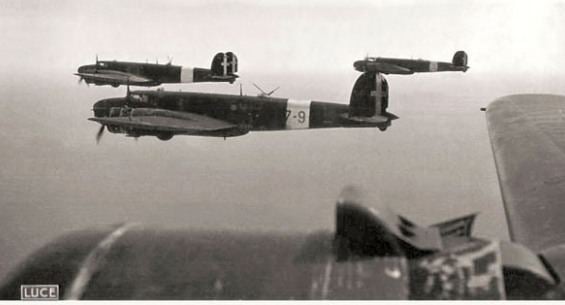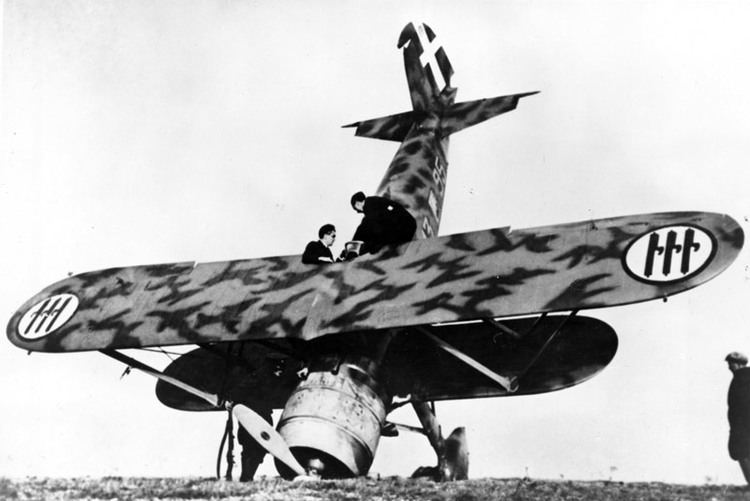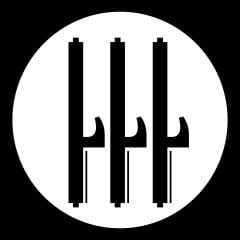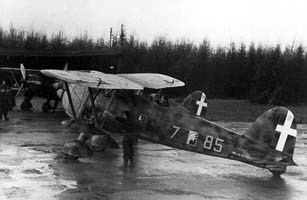 | ||
Similar Regia Aeronautica, Aeronautica Nazionale Repubblicana, Aviazione Legionaria, Italian Co‑belligerent Air Force, Italian Expeditionary Corps in | ||
Hurricane vs the corpo aereo italiano by s ren dalsgaard
The Corpo Aereo Italiano (literally, "Italian Air Corps"), or CAI, was an expeditionary force from the Italian Regia Aeronautica ("Royal Air Force") that participated in the Battle of Britain and the Blitz during the final months of 1940 during World War II. The CAI supported the German Air Force (Luftwaffe) and flew against the British Royal Air Force (RAF). The CAI achieved limited success during its brief existence, but it was generally hampered by the inadequacy of its equipment.
Contents
- Hurricane vs the corpo aereo italiano by s ren dalsgaard
- Formation
- Aircraft
- Operations
- Redeployment
- Impact
- Biplane versus monoplane
- References

Formation

Italian dictator Benito Mussolini insisted on providing an element of the Italian Royal Air Force (Regia Aeronautica) to assist his German ally during the Battle of Britain.

On 10 September 1940, the CAI was formed, under the formal aegis of the 1a Squadra Aerea di Milano ("First 'Milan' Air Command"). Air Marshal (Generale S.A.) Rino Corso-Fougier was appointed Air Officer Commanding.
Aircraft

Supporting aircraft included five CANT Z.1007 used for reconnaissance and Caproni Ca.133 transport planes.
On 25 September, the bombers arrived at their airfield in Melsbroek, Belgium after an eventful journey in which several planes force landed or even crashed due to malfunctions and poor weather. The fighter element arrived later at Ursel, Belgium.
Operations
On the night of 24 October 1940, the CAI conducted its first raid, when 18 BR.20s took off to attack Harwich and Felixstowe. Not all aircraft found their targets and three were lost in accidents.
The next major operation of the CAI was on 29 October. This date is regarded by some historians as the last day of the Battle of Britain. In response to a raid on several northern Italian cities, fifteen BR.20s with a strong fighter escort bombed Ramsgate by day. The Italian bombers were sighted crossing Kent at a relatively low level. The bombers flew in formation, wingtip to wingtip. The open-cockpit, fixed-undercarriage fighter escorts accompanied them in a similar immaculate order. The Italian aircraft were painted pale green and bright blue. This was camouflage more suitable for a more exotic climate than that found in Britain in late October. Five Italian aircraft suffered damage due to anti-aircraft guns. At least one of the bombers was seen at 16:40 hours in Deal, Kent that afternoon, some 14 miles from Ramsgate and dropped three high-explosive bombs, one just outside the Officers' Mess at the Royal Marines Depot, killing Second Lieutenant Nelson, four Marines, and one private from the King's Shropshire Light Infantry. All but one were buried together in the Hamilton Road Cemetery, Deal.
The next few days saw several small raids.
On 11 November 1940, the day before the battle fleet of the Regia Marina (the Italian navy) was attacked at Taranto by the Royal Navy's aircraft and as a result lost half of its capital ships, the CAI saw its first major combat against the RAF. Ten bombers were escorted by forty-two CR.42s, G.50s, and some German Messerschmitt Bf 109s assigned to them. The G.50 mission was aborted due to bad weather that caused too much fuel consumption and the Fiat had to go, leaving only the CR.42 as escort. However, Hurricanes from several units, belonging to 257, 46, and 42 Squadrons intercepted the aircraft and destroyed three bombers and two fighters, while another was lost to mechanical fault or navigation herror, the pilot (Salvatori) was captured. In addition, four bombers eventually force landed, two fighters were destroyed on landing, and another eight fighters landed with damage, with over 20 aviators missing, dead or wounded. British had two fighters slighty damaged. One of the Fiats (MM.5701) was repaired by the British and subsequently evaluated by E.Brown; this is one of the best conserved CR.42s, and it is owned by an UK museum (Hendon).
Fighter to fighter combat was no more successful for the CAI. On 23 November, the Italian biplanes were "bounced" by Spitfire Mk.IIs and two were shot down by Archibald Winskill with several others damaged, in return for one Spitfire damaged.
Further bombing raids were carried out by the CAI, mainly on the Ipswich and Harwich areas.
By the end of December, shortly before its redeployment, the CAI had flown 97 bomber sorties, for the loss of three aircraft. The Italian planes had dropped 44.87 tonnes of bombs in 77 night sorties, most of them over Harwich.
Redeployment
Near the beginning of January 1941, all of the bombers and biplanes were redeployed. This left the CAI with only the Fiat G.50s, which remained until mid-April 1941, when they too were redeployed.
Impact
The first operation by the CAI was on 28 October. As late as 4 November, a Time magazine article only indicated that there was a possibility that an Italian air force unit might be sent to participate in the Battle of Britain.
Biplane versus monoplane
Although the main fighter used by the Corpo Aereo Italiano was a biplane, which, in purely technical terms, would be outclassed by more modern monoplanes, this was not the case all the time. On 11 and 23 November 1940, CR.42s flew two raids against Great Britain as part of the Corpo Aereo Italiano. Although the German Luftwaffe aircraft had difficulty flying in formation with the slower biplanes, the Falcos, though slower, and with an open cockpit, no radio, and armed with only two machine guns (a 12.7 mm/.5 in and a 7.7 mm/.303 in Breda-SAFAT), could easily out-turn Hurricanes and Spitfires, making them difficult to hit. "The CR 42 turned to fight using all the aeroplane's manoeuvrability. The pilot could get on my tail in a single turn, so tightly was he able to pull round." As the RAF intelligence report stated, the Falcos were hard targets. "As I fired he half rolled very tightly and I was completely unable to hold him, so rapid were his manoeuvres. I attacked two or three more and fired short bursts, in each case the enemy aircraft half-rolled very tightly and easily and completely out-turned me. In two cases as they came out of their rolls, they were able to turn in almost on my tail and opened fire on me."
Against British monoplanes, the CR.42s were not always outclassed. "I engaged one of the British fighters from a range of between 40 to 50 metres (130–165 ft). Then I saw a Spitfire, which was chasing another CR.42, and I got in a shot at a range of 150 metres (500 ft). I realised that in a manoeuvered flight, the CR.42 could win or survive against Hurricanes and Spitfires, though we had to be careful of a sweep from behind. In my opinion, the English .303 bullet was not very effective. Italian aircraft received many hits which did no material damage and one pilot even found that his parachute pack had stopped a bullet."
